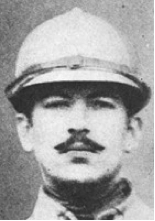 Alan Seeger had only a short life. He was an idealist with, some might say, an unrealistically romantic view of death. He wrote a poem, which has become his most famous piece of work, called I Have a Rendezvous with Death. We will never know if he really and truly believed these words at the time that he wrote it but one has to assume that he did. There is a certain eerie coincidence in the fact that this poem was a favourite of John F Kennedy. His wife Jackie memorised it word for word. It’s an intriguing thought but maybe President Kennedy also had a similar premonition to that of Seeger regarding an early death.
Alan Seeger had only a short life. He was an idealist with, some might say, an unrealistically romantic view of death. He wrote a poem, which has become his most famous piece of work, called I Have a Rendezvous with Death. We will never know if he really and truly believed these words at the time that he wrote it but one has to assume that he did. There is a certain eerie coincidence in the fact that this poem was a favourite of John F Kennedy. His wife Jackie memorised it word for word. It’s an intriguing thought but maybe President Kennedy also had a similar premonition to that of Seeger regarding an early death.
Seeger was born in June 1888 in New York and he lived here and on Staten Island for the first ten years of his life. When he was 12 the family moved to Mexico and it is said that the two years spent there influenced his future style of poetry. On his return to the States he was able to attend a number of elite preparatory schools before being admitted to Harvard. A fellow student there was the famous writer T S Elliott. He set down his early poetry while here and also wrote for the in-house magazine “Harvard Monthly”.
Following graduation in 1910 he took up residence in the trendy Greenwich Village area of New York and, without any urgent need to take up paid employment, spent his time writing poetry and being the “Bohemian man about town”. He enjoyed some early French influence from frequent visits to Mlles. Petitpas’ boarding house where there were frequent soirées for the benefit of the artistic fraternity of the city, including the father of the famous Irish poet W B Yeats.
In August 1914 he took up residence in the Paris Latin Quarter. Here he continued in a similar lifestyle to that enjoyed in Greenwich Village. It is curious then that he moved from the easy, relaxed life of the intellectual to the much harsher environment of the trenches. His “early rendezvous with death” premonition must have inspired him to join the French Foreign Legion and fight the Germans. His countrymen did not join the war until 1917 and, by that time, Seeger was dead.
This apparent headlong dash towards his own demise was remarkable considering that his brother Charles Seeger was a committed pacifist and musicologist who later raised the musical trio of folk singers Pete, Mike and Peggy Seeger (all of whom wrote and performed anti-war songs later in the 20th century).
Alan continued to write poetry while serving as a soldier but none of it was published until a year after his death. There is a recurring fatalistic theme throughout much of his writing and it seems that he could see his own glorious death only just over the horizon. His collection called simply Poems (published in 1917) was not particularly successful and some said that his idealistic style was not suited to the times. His old friend T S Elliott gave it a fairly generous review though despite some of the work being:

Not long before Seeger was killed in battle he wrote in tribute to fallen American heroes called Ode in Memory of the American Volunteers Fallen for France and it is reproduced below:

Perhaps Alan Seeger new the end was close at hand and, on the 4th July 1916, he was shot several times in a machine gun burst of fire. He was 28 years old.
Here are the last few lines of his most famous poem. It seems that he was only a few months out when predicting his own death:


